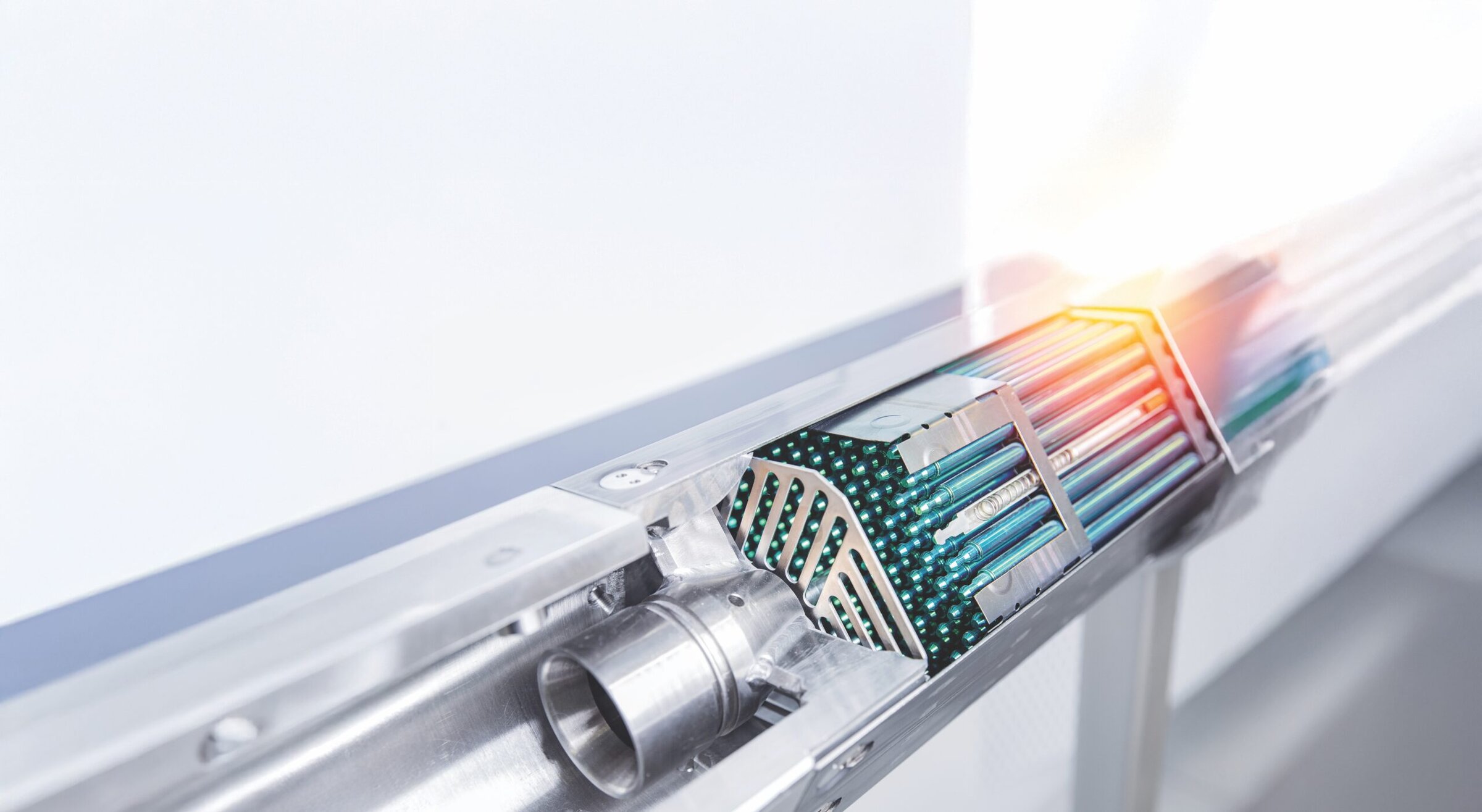Nuclear energy is experiencing a revival as countries aim to reduce their dependence on fossil fuels while ensuring enough energy supply to support the future needs of a growing population and human activities.
Currently, approximately 10% of the world’s electrical energy is provided by nuclear power plants, according to the World Nuclear Association.1 During the 2023 United Nations Climate Change Conference, a group of 22 countries set a goal to triple their nuclear power capacity by 2050. Accomplishing this goal, however, will depend heavily on securing a steady supply of the materials used as fuel in nuclear reactors.
Uranium: Current champion of the nuclear fuel market
Today’s commercial nuclear power plants all rely on fission to generate electricity. This process entails the irradiation of a fissile material with neutrons to split the heavy nucleus of the material’s atoms into smaller nuclei. The thermal energy produced during fission is used to produce steam to drive a turbine and a power generator.
Until now, uranium, more specifically the isotope 235U, has been the most common fissile material globally. However, the 235U isotope is present in nature at very low concentrations, just 0.7% by mass versus 99.3% for 238U. Because the 238U isotope is not as fissile as the 235U isotope, the two isotopes must be separated using a process called “enrichment” before being used in a nuclear power plant. The flow diagram in Figure 1 provides a high-level look at the enrichment process and subsequent application of the enriched uranium-based fuel.
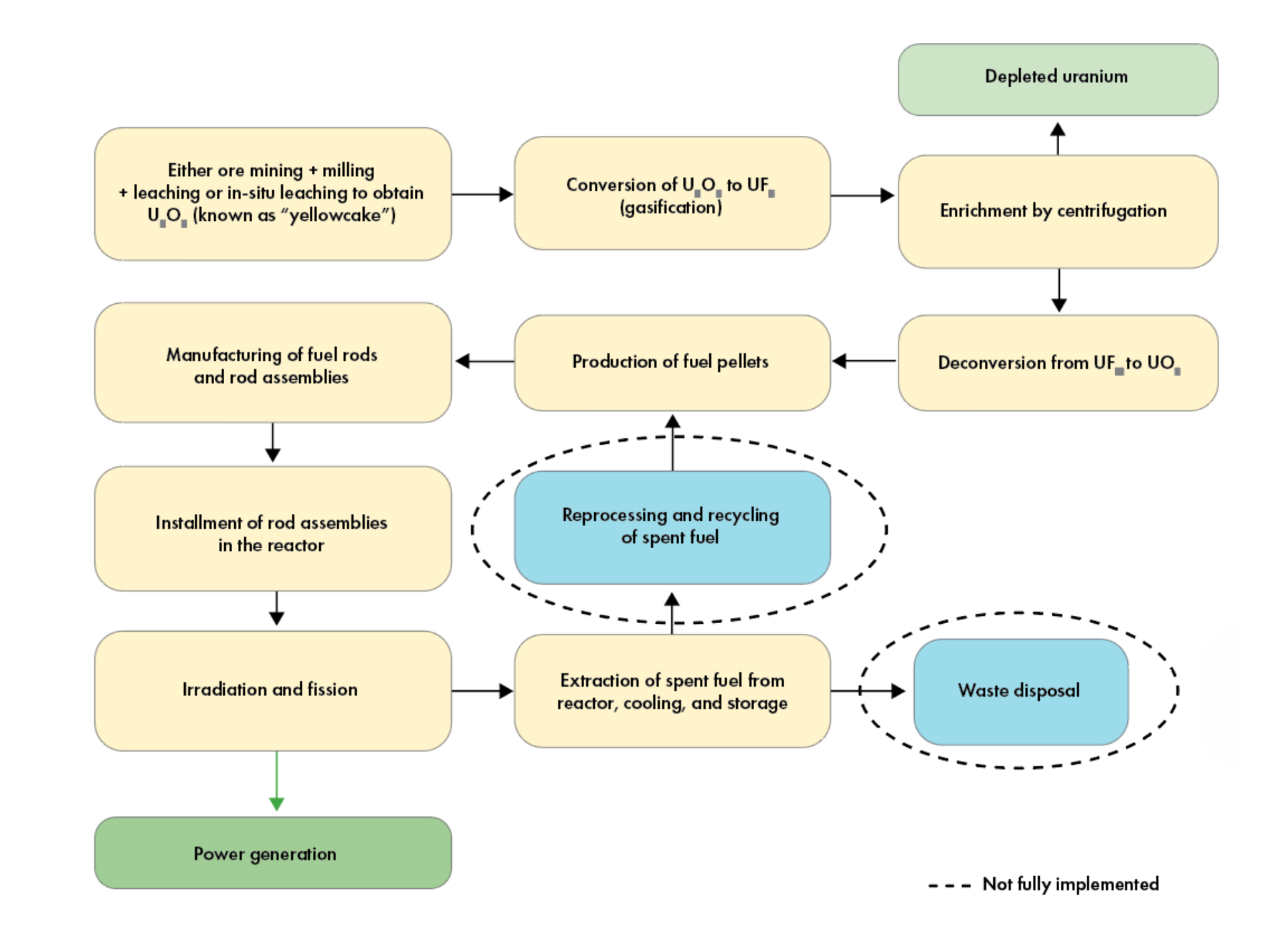
Figure 1. Enrichment and application of uranium-based nuclear fuels. Credit: AMG NewTech
Low-enriched uranium (LEU) contains less than 20% 235U and is utilized in commercial applications, whereas highly enriched uranium (HEU) contains more than 20% 235U and is reserved for nuclear weapons, submarines, and nuclear research. At present, 95% of all nuclear power plants rely on LEU with 2% to 5% enrichment.2 Canada is the only country that has introduced nuclear reactors based on nonenriched uranium, called CANDU reactors.
Recently, countries have become interested in the possibility of high-assay, low-enriched uranium (HALEU), which is uranium enriched to between 5% and 20%. HALEU is expected to provide benefits such as longer fuel life, less downtime, fewer operational costs, and less nuclear waste.
Currently, only Russia and China are capable of manufacturing HALEU in high volumes. In the U.S., Centrus Energy (Bethesda, Md.) is the only commercial producer of HALEU, and it is ramping up capacity to approximately 1 ton per year. Analysts project it will take at least another four years to achieve production of commercial quantities of HALEU in the U.S.
Barriers to enriched uranium production
Besides challenges in sourcing uranium (see sidebar: “Uranium supply and demand”), there are various barriers to entry that limit production of enriched uranium, including complexity of technology, expensive capital investments, high production costs, and international limits aiming at avoiding proliferation of nuclear weapons. Consequently, there are only a handful of suppliers globally (Table 1).3
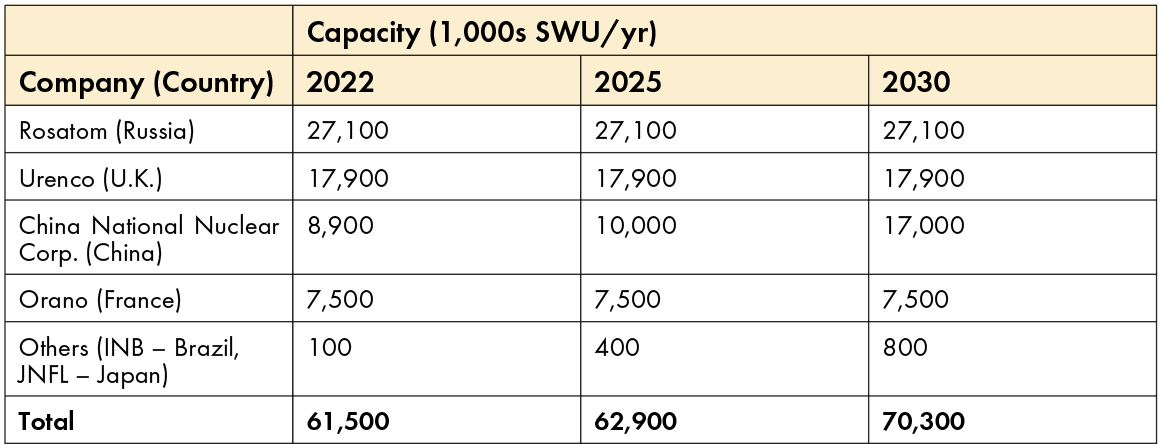
Table 1. Global suppliers of enriched uranium. Note: SWU = Separative Work Unit. This standard unit to measure enriched uranium is not a unit of mass but a measure of the separation process. Credit: World Nuclear Association3
Among the suppliers, China National Nuclear Corp. primarily serves the domestic market. So, there are really only three major suppliers worldwide, the largest of which is Rosatom (Russian State Atomic Energy Corp.), which produces 43.1% of all enriched uranium, according to the World Nuclear Association.3 Currently, the U.S. can only fill less than 5% of its needs.4 By comparison, Europe is in a better position because the domestic suppliers Urenco and Orano supply two thirds of the region’s enriched uranium demand. (Though Europe-based, Urenco and Orano also have plants in the U.S.)
After the invasion of Ukraine in February 2022, many countries implemented measures to reduce their reliance on imports from Russia. These policies contributed to a rapid increase of activities aimed at boosting the national supply of nuclear fuels. For example, four U.S. companies recently were issued contracts by the Department of Energy to produce HALEU: Louisiana Energy Services (Eunice, N.M.), Orano Federal Services (Federal Way, Wash.), General Matter (San Francisco, Calif.), and American Centrifuge Operating (Piketon, Ohio). Additionally, six companies were awarded contracts to convert HALEU to oxides or metal fuel: Framatome (Lynchburg, Va.), BWXT (Lynchburg, Va.), Centrus (Bethesda, Md.), GE Vernova (Cambridge, Mass.), Orano (Bethesda, Md.), and Westinghouse (Cranberry Township, Pa.).
Alternative, more efficient, and cost-effective enrichment technologies are also being introduced, such as a laser enrichment process called SILEX that Global Laser Enrichment (Wilmington, N.C.) is working to develop and commercialize.
Alternative nuclear fuels
Since the early prototypes were introduced in the 1950s, nuclear reactor design has evolved (Table 2),5,6 though light water reactors (LWRs), which are moderated and cooled by water, remain the most popular category. In fact, all the 94 reactors currently operating in the U.S. are LWRs. In contrast, nuclear fuel has remained virtually unchanged for decades. Most reactors still utilize UO2, though newer fuels started to emerge near the end of the 20th century.
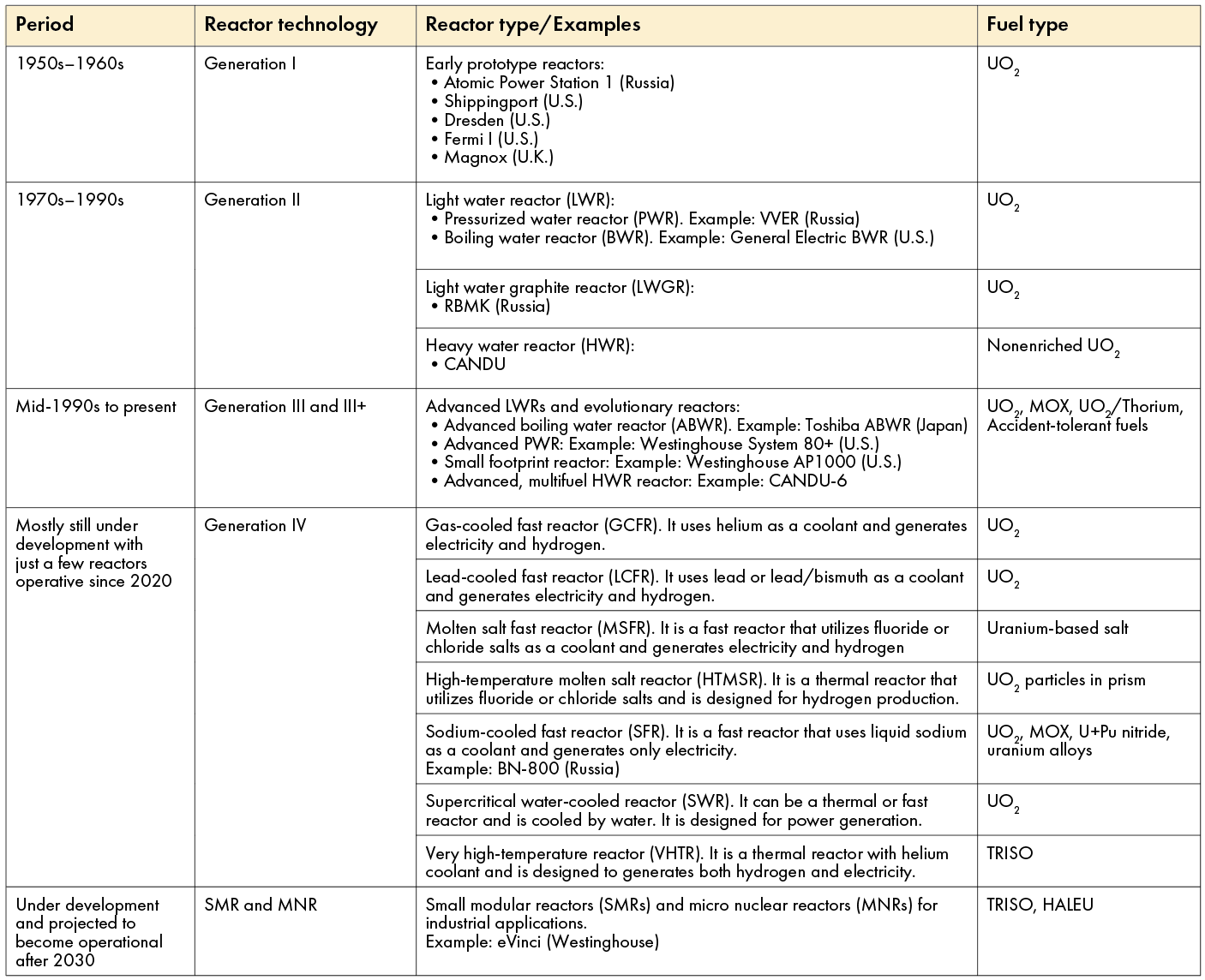
Table 2. Advancements in nuclear reactor and fuel technology. Credit: U.S. Department of Energy,5 World Nuclear Association,6 AMG NewTech
MOX
A new fuel chemistry called MOX was introduced in the 1980s, consisting of mixed uranium and plutonium oxides. MOX was developed with the purpose of reprocessing and recycling depleted uranium and spent nuclear fuel from both commercial reactors and weapon programs. Spent nuclear fuel contains plutonium generated from the decay of uranium during fission. All plutonium isotopes are fissionable, i.e., they can still undergo fission when irradiated with fast neutrons. The main advantage of MOX is that it does not require further enrichment.
Some reactors were built to be compatible with MOX, but they continued to use just UO2. As a result, MOX-fed reactors became operational only in the late 1990s and early 2000s, with the commercialization of Gen III reactors.
Accident-tolerant fuels
Accident-tolerant fuels (ATFs) were introduced after the 2011 Fukushima Daiichi nuclear disaster in Japan. These uranium-based fuels aim to improve the safety of reactors through the use of additives and cladding designs. Additives such as chromium, magnesium, and titanium are used to increase grain size and fuel plasticity in ATFs, which ideally will help with optimizing the retention of fission gases, achieving higher conductivity, and preventing fuel pellet failure.
Among the various ATF types, chromia-based UO2 is of particular interest because it has been demonstrated to enhance grain growth during sintering, enabling retention of gaseous fission products.7 This property is important in newer light water reactors, as it allows them to reach burn-ups of up to 70 GWd/tU. (Higher burn-up extends the life of the nuclear fuel from 12–18 months to 24 months, thus reducing the amount of spent fuel.)
An example of a commercial ATF is the Advanced Doped Pellet Technology (ADOPT) by Westinghouse (Cranberry Township, Pa.). This fuel pellet contains uranium doped with chromia and alumina and features higher burn-up, gas retention capability, thermal stability, and enhanced corrosion resistance.
TRISO
TRISO, which stands for tri-isotropic-layered particles, was invented in Germany in the 1980s for very high-temperature reactor applications. This fuel consists of very small spherical particles (less than 1 mm in diameter) comprising a UO2 /UC2 kernel that is coated with three layers via chemical vapor deposition. The first layer is a porous carbon that retains fission gases; the inner layer is made of silicon carbide to hold fission products; and the external layer is made of carbon to improve particle strength.
This fuel, which can withstand temperatures as high as 1,800°C, is produced in the U.S. by BWX Technologies (Lynchburg, Va.). It was recently selected for the first high-temperature gas cooled reactor (HTGR) under development by X-Energy (Rockville, Md.).8
Thorium-based fuels
Thorium-based fuels are considered to be more proliferation resistant than uranium-based fuels because they do not generate plutonium, an essential component of nuclear weapons. Additionally, during decay, thorium becomes a highly radioactive material that is complex to handle, which acts as a deterrent for thieves.
There are large resources of thorium worldwide, estimated at 6.4 million metric tons.9 Thorium can be found in rare earth-rich minerals such as monazite and heavy mineral sand deposits. China and India have an abundance of these minerals and are actively pursuing the use of thorium as a nuclear fuel. China has already built an experimental thorium molten salt reactor that reached full power in 2024.
Fuels for Generation IV and other future reactors
Reactors for Gen IV and beyond are being designed to provide enhanced safety, lower capital and production costs, minimal waste, and proliferation resistance. Although they are still being developed primarily on uranium-based fuels, their design does not exclude the possibility of using different fuel types. A variety of materials are being developed to help future reactors reach their objectives. The most relevant ones are summarized in Table 3.
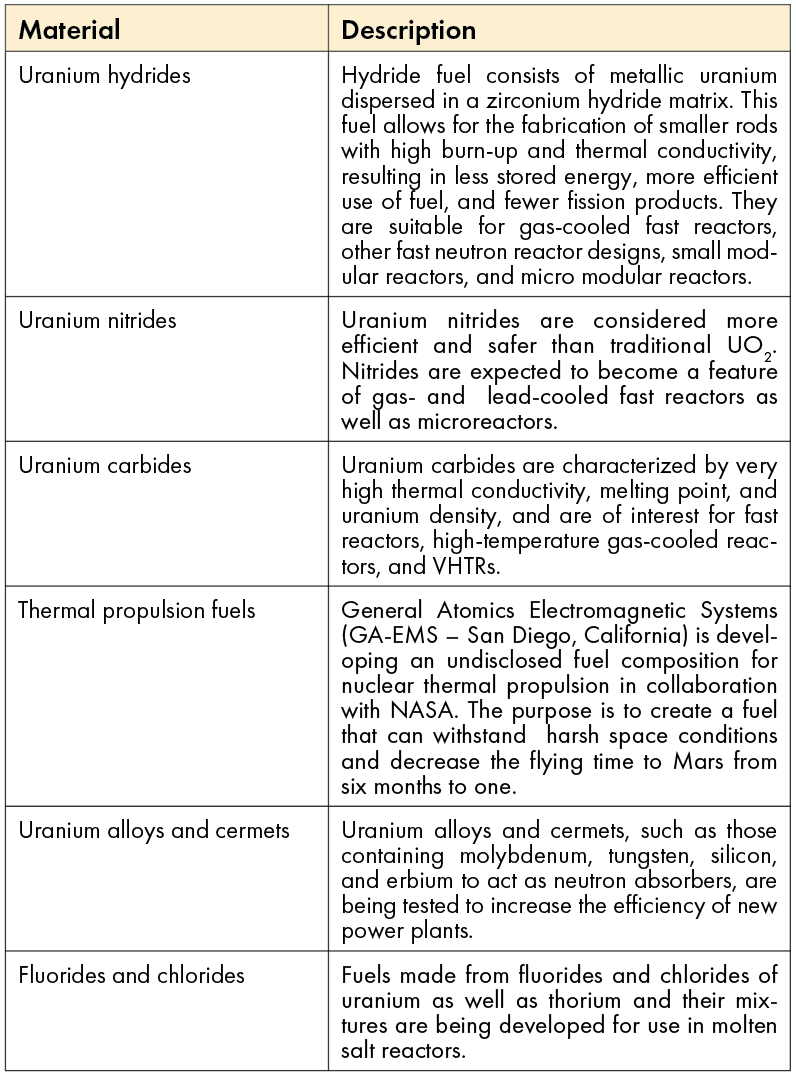
Table 3. Emerging materials for nuclear fuels. Credit: AMG NewTech
Proliferation risks
As countries plan to significantly increase their consumption of nuclear fuels during the next few decades, there is a more urgent need to find a way to permanently dispose of waste fuel. According to the International Atomic Energy Agency, since the 1950s, approximately 430,000 metric tons of spent fuel has been generated globally, of which only 30% has been reprocessed.10
At present, spent fuel is usually stored onsite at the nuclear plant. In the U.S., 92,500 metric tons of waste is stored at 100 sites across the nation. Some countries are taking action to find locations for permanent disposal, such as underground geological repositories. Many activities are also in progress aimed at increasing the amount of fuel that is reprocessed and recycled.
Some experts believe that disposal and reutilization of fuel containing plutonium, together with the trend of using more HALEU, may increase proliferation risks because these activities create more opportunities for “bad actors” to seize materials suitable for production of weapons. Proliferation concerns cannot be underestimated, and the U.S. National Nuclear Security Administration recently announced a new study to address these concerns for new high-tech reactors.11
Conclusions
With renewed interest in nuclear energy as an alternative source of energy to support human activities and to replace fossil fuels, production of uranium at current levels and existing reserves may not be able to meet future demand during the next century. Considering that processing and use of uranium as well as disposal of spent fuel pose quite complex issues, there is a need to accelerate research and development activities in this field, especially in relation to the materials science of alternative fuels and their recycling.
Cite this article
M. Gagliardi, “Nuclear fuel market: Current trends and research opportunities,” Am. Ceram. Soc. Bull. 2025, 104(6): 40–45.
About the Author(s)
Margareth Gagliardi is owner of AMG NewTech (Charlottesville, Va.), a firm focusing on custom market research, technical studies, and consulting in advanced materials and emerging technologies. Contact Gagliardi at margarethg@earthlink.net.
Issue
Category
- Energy materials and systems
Article References
1World Nuclear Association, “World energy needs and nuclear power.” Updated 6 Jan. 2025.
2S. Patel, “Nuclear fuel: The unseen barrier ahead,” Power. Published 19 Nov. 2024.
3World Nuclear Association, “Uranium enrichment.” Updated 21 March 2025.
4World Nuclear Association, “US nuclear fuel cycle.” Updated 20 Nov. 2024.
5H. Khalil et al., “The Generation IV Nuclear Energy Systems Technology Roadmap,” Nuclear Energy Association Presentations. Published 4 Nov. 2002.
6World Nuclear Association, “Generation IV nuclear reactors.” Updated 30 April 2024.
7A. Milena-Pérez et al., “Raman spectroscopy coupled to principal component analysis for studying UO2 nuclear fuels with different grain sizes due to the chromia addition,” Journal of Nuclear Materials 2021, 543: 152581.
8D. Dalton, “US / X-energy chooses Geiger Brothers for key $40 million work at Triso-X nuclear fuel facility,” Independent Nuclear News. Published 20 Dec. 2024.
9World Nuclear Association, “Thorium.” Updated 2 May 2024.
10M. Abbà, “Finland could be the first country in the world to bury nuclear waste permanently,” Wired. Published 23 April 2025.
11T. Gardner, “US to study proliferation risk of HALEU nuclear fuel, after warning by scientists,” Reuters. Published 9 Jan. 2025.
*All references verified as of June 24, 2025.
Related Articles
Bulletin Features
Sintered synthetic cristobalite: Innovative kiln-based thermal transformation of quartz
Cristobalite, a high-temperature polymorph of silica, is widely used in ceramics, glass, paints, refractories, and dental materials due to its low density, high whiteness, thermal expansion behavior, and mechanical stability. Traditional cristobalite production methods rely on static sintering of finely ground quartz at high temperatures (~1,750°C) for extended durations (2–3…
Market Insights
Bioactive glass continues to transform medical care decades after first hitting the market
Almost 60 years ago, a chance meeting led to pioneering work that has improved medical care and seeded future innovations. In the late 1960s, a young professor named Larry Hench traveled to a conference in Sagamore, N.Y., where he happened to sit next to a U.S. Army colonel who was…
Market Insights
Sustainable development and design: Inspiration from landscape-shaping creatures
Animals are not just passive inhabitants of their environment. Many are architects of the natural world, actively shaping landforms and water bodies as they move around, feed, build homes, and reproduce. This impact by animals on different biomes has traditionally been overlooked in the environmental sciences. But scientists and engineers…
